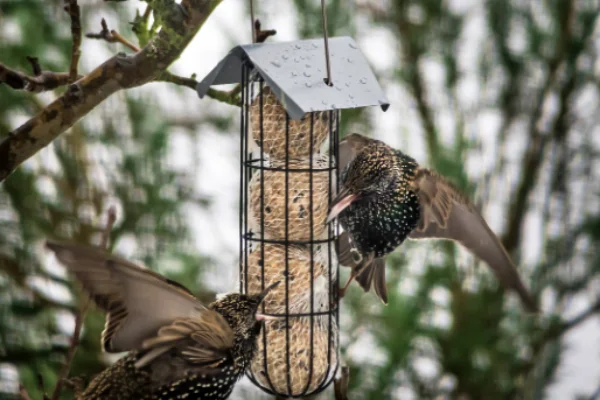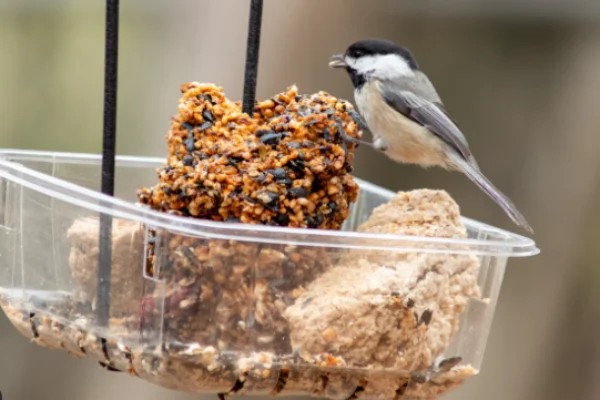Winter is the critical time of the year when Mother Nature undergoes a pause in its cycles. Every species have its respective coping mechanisms to deal with the harsh winter months. While some animals hibernate or fall into their long winter sleep, some, like the birds, have quite a tough time.
Foraging in the snowy grounds, deficient in food sources like grains or insects, becomes quite a tough job. Having a large body surface area and small volume makes birds lose heat to the surroundings more readily than others.
Therefore, they need to be in constant search of food. Animal and bird lovers around the globe have always demanded a list of items they can feed the helpless birds to add some extra calories to their winter diet. Therefore, for them, we bring today’s article, “What to Feed Birds in Winter? (New Winter Foods)”
The best food items to feed birds in winter are Suet, Black-Sunflower seeds, Peanuts, Thistle seeds, Mealworms, Mixed seeds consisting of black sunflower seeds, cracked corns and millets, Fruits and Berries, Rice, and other cereals.
Feeding these foods to the birds is relatively easy and does a lot for our winged friends.
Later in this article, on “What to feed birds in winter?” we are going to talk about each food item and elaborate on which birds like them and how you can feed them. So without much ado, let’s get going with our article.
Must Read: Nourishing Backyard Birds with DIY Bird Feeder Recipes
What to Feed Birds in Winter? (Top Winter Foods)

1) Suet:
Suet gives a variety of birds crucial calories in the harsh winters since animal fat is easily digested. Getting suet directly from your butcher is the most straightforward way to feed it to birds. Put the beef fat in a wire cage suet feeder or a mesh bag (your regular onion bags will do the job too).
Even market-purchased suet cakes will work just fine. To improve your feathered guests’ overall nutrition, you may also add fruits and nuts to the suet. This food attracts birds like the cardinals, blue jays, woodpeckers, wrens, and several others.
2) Black oil sunflower seeds:
In a test performed by the Cornell Lab of Ornithology, Black oil sunflower seeds won the seed preference test. Enriched with essential fats, it’s one of the most preferred foods by birds. Bill Thompson III mentions sunflower seeds as “hamburger” for birds.
These are easily available in any grocery store and can be simply sprinkled on the snow-covered ground or in trays.
Even regular sunflower seeds will also do great, with their smaller size and a bit lesser calories being the only drawback. It’s a favorite food of jays, nuthatches, cardinals, and house finches.
3) Peanuts:
Thompson III, in his famous magazine, Bird Watcher’s Digest, mentions peanuts and also peanut butter as a high protein, high-energy food loved by birds. However, make sure that the peanuts are unsalted. Even bird-friendly peanuts are available in the market nowadays.
Since some birds, like the woodpeckers and jays, prefer peanuts whole while nuthatches eat shelled, it’s better to provide a mix of them both. And for peanut butter, you can either mix it with suet or can spread it on pine cones or in tree bark.
4) Thistle/ Nyjer seeds:
Thistle seeds are loved by almost all the finches, from goldfinch to the common house finch. These small, needle-like, black seeds are high in oil content and are highly nutritious, making them one of the most popular birdfeed.
Finch feeders or thistle feeders are easily available in the market. Apart from finches, Nyjer seeds will attract redpolls, pine siskins, sparrows, doves, etc.
5) Mealworms:
This is a favorite food of almost every insectivorous bird-like Robins, Woodpeckers, and cardinals. Finding insects in the snow-covered ground or trees isn’t fruitful as most of them are unavailable during the harsh winter months.
With almost 53% protein and 28% fat content, dried mealworms are an excellent source of nutrition for birds. This superfood is nutrient-dense that will help our feathery friends to get going in the critical winter months.
6) Mixed Seeds:
Seed mixes comprising cracked corns, millets, and sometimes sunflower and wheat (as a filler to add volume) does an excellent job in providing a mix of all essential nutrients required by the birds. Cracked corns are not only loved by birds but by squirrels as well.
Millets, on the other hand, are a favorite food for sparrows. You might also throw in some flax seeds, dry fruits, and peanuts to add more variety to the mix. These seeds are rich in proteins, essential fats, and oils that act as a great supplement to the birds during winters.
7) Fruits and Berries:
Apples and pears are fantastic fruits to put in the bird feeder. Even bruised fruits will taste good. Fruits are a tremendous source of energy for birds because of their high water and simple sugar content, and are also a powerhouse of minerals and vitamins.
Dried cranberries, currants, and raisins are the favorites of some birds, including robins and cedar waxwings. After allowing them to soften in water for a few hours, provide them in a suet cake or on a platform feeder.
Fruits should be chopped into little pieces so that smaller birds can easily eat them. In the winter, you can feed birds with chokecherry, hawthorn, snowberry, and Rocky Mountain juniper.
8) Rice and other cereals:
Put out some bread crumbs and grated cheese to provide the birds with extra protein. Leftover food items are a treat for any bird during the winter. Cheese (better if mild cheddar) is a great choice and is popular with a broad spectrum of birds.
During harsh weather conditions, even rice, both cooked and uncooked, is welcomed. Birds such as pigeons, doves, and pheasants may consume uncooked rice.
Oats may be a good option, but there is a high probability of it sticking to the bird’s beak, causing inconveniences. Along with cereals, it is also advised to keep a bowl of water beside your bird feeder.
Must Read: Benefits And Drawbacks of Feeding Wild Birds in Summer
How to Feed Birds in Winter? (Ways to Feed)

- Bird Tables are a great choice to feed birds in winter. You can spread your desired feed on the trays and put it out in the open for birds to peck on it. Adding a bird bath is also a great choice, as it will provide the bird’s water to drink and clean themselves after a meal.
- Hanging bird feeders have their advantage. Birds’ tables, since it’s easily reachable, may attract predators like raccoons, foxes, etc. Hanging feeders are out of reach of these animals and are solely for use by birds. You may hang them down on tree branches, from the ceiling, or even from a lamp post.
- You may purchase your feed from the local store, or if it is a mix, you may mix the ingredients at home. Sprinkling it in the ground may lead to wastage and hence filling it in birdfeeders or trays are the better option.
- Hygiene is essential and should be maintained continuously. Cleaning the feeders, especially if the feed was suet, lards, or mealworms, is important, as they may become breeding grounds for all sorts of bacteria and viruses. These microorganisms may lead to foul smells attracting predators or may even cause diseases, which might spread from one bird to other.
- Make sure the food you provide is devoid of salt, onion, garlic, etc. These substances are toxic to birds and may cause several complications, like stomach upsets. Bread, if given, should be fresh and not moldy. Chocolate and milk are the other two bad choices for bird food.
- Nowadays, since the world is moving towards sustainability, coconut shells and pine cones may serve as excellent bird feeders. All we need to do is to make a hole in the shell and insert a string to hang it down. Now we can fill it with suet balls. To make these fat balls, simply add suet or lard to your pan, and when it starts welting, add your desired bird feed, like seed mix. When things cool down, stuff it inside the shell and hang it down. As for pine cones, simply fill the cracks and spaces with suet or even peanut butter and leave them for birds to enjoy.
List of Best Bird Foods (For every season)

During Summer:
- Seeds like the black sunflower seeds
- Fruits
- Nectar (primarily for hummingbirds)
- Mealworms
- Do not forget to place a bird bath along with food.
During Autumn:
- Seeds like Black sunflower, Nyjer, Flax, etc
- Peanuts
- Nectar
During Winter:
- Suet
- Black Oil Sunflower Seeds
- Nyjer Seeds
- Millets
During Spring:
- Seeds
- Fruits
- Mealworms
Here, we conclude our article, “What to Feed Birds in Winter?” The simple act of putting out a tub of water or some food will make a phenomenal difference to the world around you.
Birds are essential for our ecosystem, and they do not have yearlong access to food like humans. Therefore, these simple acts of kindness will not only help to strengthen the bird population around you but will also keep insects in check. After all, amidst the chaos around us, birds’ chirpings are healing the soul.
Also Read:

Meet Abhidept (nickname Monty), the visionary founder of How It See, being an engineering student, he’s fueled by an insatiable curiosity about the world around him. He is captivated by an eclectic correlation between animal groups, science, and nature, and this fascination drives his quest for understanding.
After completing his degree, he’s set on a mission to delve deep into the realm of nature, accumulating knowledge to share with you through his writing. In the meantime, he loves to watch anime and read anime.
